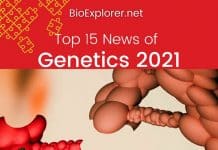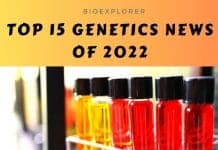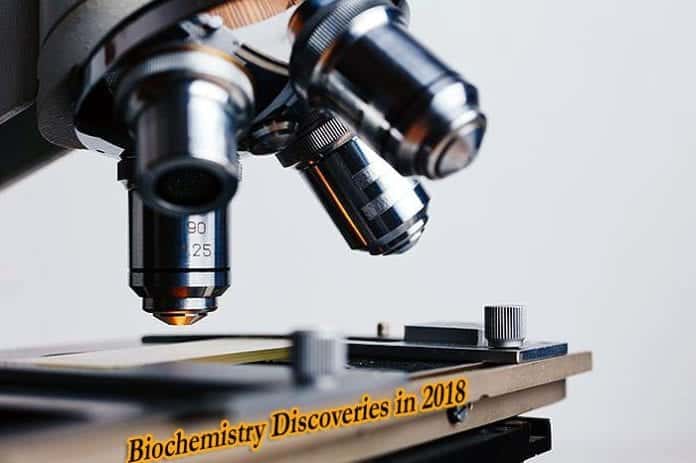
Biochemistry seems a purely theoretical science with little application to practical problems. Progress in different areas of biochemical research, especially glycomics, can lead to better therapy and understanding of how own bodies work. Here are the top 15 biochemistry news in 2018.
Table of Contents
- Top 15 Biochemistry News in 2018
- 1. Sortase A: a peptide designer of bacterial origins
- 2. Looking inside plants: a new mass spectrometry technique
- 3. Following the glycans: glycomics helps in studying human diseases
- 4. Nanotechnology against cancer.
- 5. Genes, carbohydrates and blood groups: a novel discovery on the threshold between biochemistry and genetics.
- 6. Becoming focused: a new fluorescence assay that deletes the unnecessary
- 7. The light control: optogenetics to study self-assembling molecules.
- 8. Raman Hunter: Using Raman Spectroscopy to catch malignant cells.
- 9. Newly discovered addition to cancer weaponry: FOXA1
- 10. The RNA that promotes cancer
- 11. Eucalyptus leaves as a natural herbicide
- 12. Mimicking nature: a class of nanoparticles with wonderful properties
- 13. The dual role of mucins in plant parasites.
- 14. An intricate mechanism to keep the muscles fed: how exercise leads to glycogen super-compensation.
- 15. Carbohydrates as poison: certain sugars are officially deemed toxic
Top 15 Biochemistry News in 2018
1. Sortase A: a peptide designer of bacterial origins
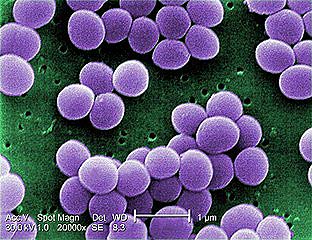 The newly produced protein chains undergo post-translational modifications with the help of a class of enzymes called sortases.
The newly produced protein chains undergo post-translational modifications with the help of a class of enzymes called sortases.
- Bacteria have some highly efficient sortases that allow scientists to replicate these natural processes in the lab. For instance, sortase A, an enzyme produced by S. aureus, is approximately 20 more efficient compared to other enzymes of its class.
- It is now widely used for altering and fine-tuning proteins in vitro, allowing the development of multiple proteins with novel functions artificially.
![]()
2. Looking inside plants: a new mass spectrometry technique
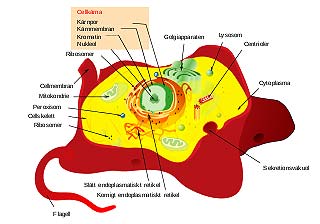 Mass spectrometry is an approach that allows us to see and analyze molecules.
Mass spectrometry is an approach that allows us to see and analyze molecules.
- One of the most progressive mass spectrometry methods called MALDI‐MSI takes even further – it visualizes molecular structures directly inside the cells.
- Previously, it was possible to look into animal cells only, as plant cells have robust cell walls.
- Novel protocols help overcome these obstacles and allow observation of macromolecules in cells of the roots and leaves of the plants, giving the scientists an insight into complex biochemical machinery of these organisms.
![]()
3. Following the glycans: glycomics helps in studying human diseases
 In popular opinion, carbohydrates are those complex compounds that can provide us with energy or contribute to such systemic diseases that like diabetes or obesity.
In popular opinion, carbohydrates are those complex compounds that can provide us with energy or contribute to such systemic diseases that like diabetes or obesity.
- However, carbohydrates fulfill a wider variety of functions. For instance, a carbohydrate called glycans is essential for glycoproteins production.
- Glycoproteins, in their turn, are crucial in cellular recognition and development. Thanks to novel methods such as mass spectrometry and bioinformatics, it is now clear that glycans are critical regulators of the metabolism both in healthy cells and in malignant ones.
![]()
4. Nanotechnology against cancer.
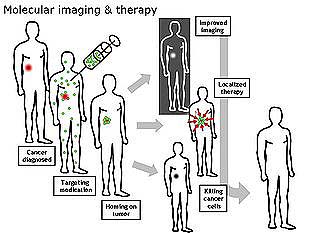 The modern cancer therapy aims to use drugs that can be safely delivered to the target cells in specific quantities and this becomes possible due to nanotechnology.
The modern cancer therapy aims to use drugs that can be safely delivered to the target cells in specific quantities and this becomes possible due to nanotechnology.
- A new kind of nanoparticle of two anti-cancer drugs, raltitrexed and clofarabine was developed.
- These particles can self-assemble into a double raltirexed-clorafabine molecule that has synergistic properties.
- Such nano molecules can be delivered directly into the tumor, suppress the cell cycle of the cancer cells and prevent cancer progression.
![]()
5. Genes, carbohydrates and blood groups: a novel discovery on the threshold between biochemistry and genetics.
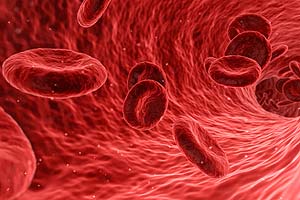 Glycosyltransferases are a class of diverse proteins that are responsible for protein glycosylation.
Glycosyltransferases are a class of diverse proteins that are responsible for protein glycosylation.
- They are also crucial for the production of glycoproteins expressed on the surface of red blood cells (RBC) and used for blood group classification.
- Genetic and bioinformatics analysis has established some genes that code for such proteins.
- There are around 30 genes that influence the blood groups of RBCs and can potentially lead to blood disorders in case of mutation.
- This analysis also has led to the discovery of a novel blood group system.
![]()
6. Becoming focused: a new fluorescence assay that deletes the unnecessary
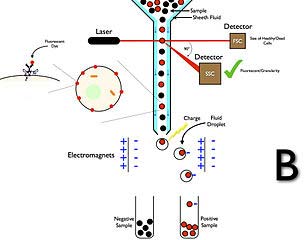 A new protocol for fluorescence assay with the use of the so-called single-molecule centroid localization has been developed.
A new protocol for fluorescence assay with the use of the so-called single-molecule centroid localization has been developed.
- This algorithm allows studying even weak molecule-molecule interactions, focusing on actual binding events.
- This approach allows more accurate analysis of molecular interactions without significant changes to the overall experimental routines.
![]()
7. The light control: optogenetics to study self-assembling molecules.
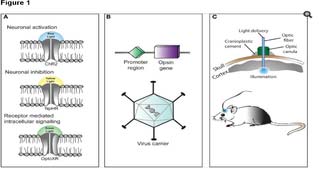 Optogenetics is a novel method of using light for directing and controlling biological processes.
Optogenetics is a novel method of using light for directing and controlling biological processes.
- It was extraordinarily successful in nerve cells studies. Now the same technique was applied in an entirely novel way.
- Optogenetics was found to be useful in studying the ability of proteins and nucleic acids to self assemble.
- These molecules can form gels and clusters by themselves, and optogenetics can precisely dissect such structures, allowing studies of their development and function.
- As these processes are crucial for the development of living organisms, the researchers were given a powerful tool for understanding embryonic development and even the evolution of organisms.
![]()
8. Raman Hunter: Using Raman Spectroscopy to catch malignant cells.
Raman spectroscopy (RS) was used previously in crystallography and chemistry, as it allows precise analysis of molecular structure.
- At present, it is now also applied for significantly bigger targets. RS was successfully used for the analysis of white blood cells.
- It was found that this approach not only allows to distinguish blood cell types accurately, it also can determine the presence of malignant blood cells, which makes this approach useful in leukemia diagnosis.
![]()
9. Newly discovered addition to cancer weaponry: FOXA1
 TGF-β is a potent apoptosis inducer. However, cancer cells – for instance in certain types of breast cancer- are resistant to its influence.
TGF-β is a potent apoptosis inducer. However, cancer cells – for instance in certain types of breast cancer- are resistant to its influence.
- Now the researchers are beginning to understand why. It was found that breast cancer cells express a protein called forkhead box protein A1 (FOXA1) that interferes with TGF-β – induced cascade.
- FOXA1 prevents binding of the transcription factor Smad3 to the nuclear receptor importin 7, thus preventing the initiation of pro-apoptotic genes transcription.
- This discovery makes FOXA1 a potential drug target in breast cancer treatment.
![]()
10. The RNA that promotes cancer
Long non-coding RNAs (lncRNAs) are powerful epigenetic regulators. One of the lncRNAs, XIST, is known to promote cancer growth.
- It was established that in osteosarcoma cells, XIST competes with another regulating RNA, miR‐195‐5p, an RNA that suppresses an anti-apoptotic YAP protein.
- Thus, XIST promotes proliferation of osteosarcoma cells through interfering with this pathway.
- This discovery has not only elucidated the mechanism through which XIST is promoting osteosarcoma development but also has proven that XIST can be a promising target for cancer therapy.
![]()
11. Eucalyptus leaves as a natural herbicide
 It was found that an aqueous solution of eucalyptus leaves can suppress the growth and development of other plants.
It was found that an aqueous solution of eucalyptus leaves can suppress the growth and development of other plants.
- This solution contains a mix of substances that have herbicidal properties.
- Based on experimental results, eucalyptus leaves extract is recommended as natural herbicide and can be useful as such if put in the soil before the actual planting.
![]()
12. Mimicking nature: a class of nanoparticles with wonderful properties
 Glycolipids are important components of cellular membranes in nature.
Glycolipids are important components of cellular membranes in nature.
- These molecules are amphiphilic, can self-assemble in certain circumstances, and can form liposomes and gels.
- These properties make this class of molecules an essential tool for biotechnology as well.
- At present, there is a multitude of synthetic amphiphilic nanoparticles similar in structure and organization to natural glycolipids that are used as scaffolds, gels and liposome components crucial in drug delivery and other areas.
![]()
13. The dual role of mucins in plant parasites.
 Many nematodes contain mucins in their outer cuticles. These proteins contribute to the overall ability of the parasites to infect their hosts.
Many nematodes contain mucins in their outer cuticles. These proteins contribute to the overall ability of the parasites to infect their hosts.
- Previously, only mucins of animal nematodes were studied. Now it was established that the mucin-like protein of plant nematodes is crucial for their development as well.
- By cloning and knocking out the gene responsible for the production of this protein, Mi-Muc-1, it was established that this mucin is crucial for the parasite reproduction: the worms with knocked out Mi-muc-1 gene produced fewer eggs compared to control.
- On the other hand, the mucin was also a target for nematode’s own parasites – Pasteuria penetrans bacteria.
- Fewer bacterial endospores attached to the surface of parasites with knocked out Mi-muc-1 gene compared to the control.
![]()
14. An intricate mechanism to keep the muscles fed: how exercise leads to glycogen super-compensation.
 In a series of experiments carried out in men and mice, it was found that a single episode of exercise leads to activation of several proteins responsible for glucose uptake.
In a series of experiments carried out in men and mice, it was found that a single episode of exercise leads to activation of several proteins responsible for glucose uptake.
- Under the control of AMPK (5′ AMP-activated protein kinase) and glucose synthase, the uptake of glucose and production of glycogen is significantly increased, leading to glycogen super-compensation.
- Though glycogen supercompensation in muscles was known before, the overall mechanism and critical regulators of this process were described for the first time.
![]()
15. Carbohydrates as poison: certain sugars are officially deemed toxic

- Multiple reports have shown that increase uptake of carbohydrates, especially increased the content of refined sugars in the diet, can lead to toxicity.
- The overuse of certain types of carbohydrates speeds up aging, leads to obesity, diabetes and other metabolic disorders, while a decrease in carbohydrate content in the diet has multiple beneficial effects.
![]()
As we can see, the year 2018 was mostly devoted to the properties of carbohydrates and glycoproteins. The researchers slowly understand the complex networks of proteins that are the basis in health and disease, especially cancer.
![]()




